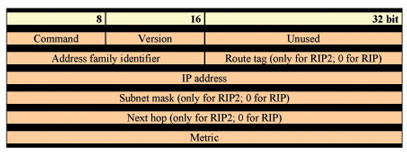In preparation of your CCNA exam, we want to make sure we cover the various concepts that we could see on your Cisco CCNA exam. So to assist you, below we will discuss one of the more difficult CCNA concepts; Routing Information Protocol (RIP). As you progress through your CCNA exam studies, I am sure with repetition you will find this topic becomes easier. So even though it may be a difficult concept and confusing at first, keep at it as no one said getting your Cisco certification would be easy!
RIP and RIP2: Routing Information Protocol
RIP (Routing Information Protocol) is a standard for exchange of routing information among gateways and hosts. RIP is most useful as an “interior gateway protocol”. In a nationwide network such as the current Internet, there are many routing protocols be used for the whole network. Rather, the network will be organized as a collection of “autonomous systems”. Each autonomous system will have its own routing technology, which may well be different for different autonomous systems. The routing protocol used within an autonomous system is referred to as an interior gateway protocol, or “IGP”. A separate protocol is used to interface among the autonomous systems. The earliest such protocol, still used in the Internet, is “EGP” (exterior gateway protocol). Such protocols are now usually referred to as inter-AS routing protocols. Routing Information Protocol (RIP) is designed to work with moderate-size networks using reasonably homogeneous technology. Thus it is suitable as an Interior Gateway Protocol (IGP) for many campuses and for regional networks using serial lines whose speeds do not vary widely. It is not intended for use in more complex environments.
RIP2 derives from RIP, which is an extension of the Routing Information Protocol (RIP) intended to expand the amount of useful information carried in the RIP messages and to add a measure of security. RIP2 is an UDP -based protocol.
RIP and RIP2 are for the IPv4 network while the RIPing is designed for the IPv6 network. In the document, only the details of RIP and RIP2 will be described.
Protocol Structure – RIP & and RIP2: Routing Information Protocol

- Command — The command field is used to specify the purpose of the datagram. There are five commands: Request, Response, Traceon (obsolete), Traceoff (Obsolete) and Reserved.
- Version — The RIP version number. The current version is 2.
- Address family identifier — Indicates what type of address is specified in this particular entry. This is used because RIP2 may carry routing information for several different protocols. The address family identifier for IP is 2.
- Route tag — Attribute assigned to a route which must be preserved and readvertised with a route. The route tag provides a method of separating internal RIP routes (routes for networks within the RIP routing domain) from external RIP routes, which may have been imported from an EGP or another IGP.
- IP address — The destination IP address.
- Subnet mask — Value applied to the IP address to yield the non-host portion of the address. If zero, then no subnet mask has been included for this entry.
- Next hop — Immediate next hop IP address to which packets to the destination specified by this route entry should be forwarded.
- Metric — Represents the total cost of getting a datagram from the host to that destination. This metric is the sum of the costs associated with the networks that would be traversed in getting to the destination.
I hope you found this article to be of use and it helps you prepare for your Cisco CCNA certification. Achieving your CCNA certification is much more than just memorizing Cisco exam material. It is having the real world knowledge to configure your Cisco equipment and be able to methodically troubleshoot Cisco issues. So I encourage you to continue in your studies for your CCNA exam certification.
